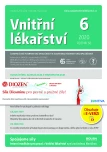Immunosenescence – the sunset over the immune system
Authors:
Zita Chovancová
Authors‘ workplace:
Lékařská fakulta Masarykovy univerzity
; Ústav klinické imunologie a alergologie, FN u sv. Anny v Brně
Published in:
Vnitř Lék 2020; 66(6): 353-358
Category:
Main Topic
Overview
Immunosenescence is characterized by remodeling and dysregulation of immune system due to aging process. These changes affect innate as well as adaptive immunity. Due to the complexity of the physiological processes, in which the mechanisms of the immune system interfere, also other systems of the organism are affected by these changes. Thymus involution as well as chronic antigenic stimulation are the main causes of immunosenescence and lead to a proinflammatory setting of the organism. In addition to impaired immune response against infections or reactivation of latent infections, reduced response to vaccination or decreased antitumor immune surveillance, changes of the immune system in elderly are clinically reflected in the development of chronic diseases typical for older age groups, such as neurodegenerative or metabolic diseases. The mechanisms of immunosenescence can be at least partially influenced by an active lifestyle and adequate dietary measures.
Keywords:
immunosenescence – aging – immune system dysregulation
Sources
1. Rychlíková J, Šterzl I. Imunosenescence – vymezení pojmu a možné souvislosti. Alergie 2004, 6(4): 240–247.
2. Nikolich ‑Žugich J. The twilight of immunity: emerging concepts in aging of the immune system. Nat Immunol 2018, 19(1): 10–19.
3. Zinger A, Cho WC, Ben ‑Yehuda A. Cancer and Aging – the Inflammatory Connection. Aging Dis 2017; 8(5): 611–627.
4. Solana R, Tarazona R, Gayoso I, Lesur O, Dupuis G, Fulop T. Innate immunosenescence: effect of aging on cells and receptors of the innate immune system in humans. Semin Immunol 2012, 24(5): 331–341.
5. Thomas R, Wang W, Su DM. Contributions of Age ‑Related Thymic Involution to Immunosenescence and Inflammaging. Immun Ageing 2020; 17: 2.
6. Romanyukha AA, Yashin AI. Age related changes in population of peripheral T cells: towards a model of immunosenescence. Mech Ageing Dev 2003; 124(4): 433–443.
7. Bischof J, Gärtner F, Zeiser K, Kunz R, Schreiner C, Hoffer E, Burster T, Knippschild U, Zimecki M. Immune Cells and Immunosenescence. Folia Biol (Praha) 2019; 65(2): 53–63.
8. Kurd N, Robey EA. T ‑cell selection in the thymus: a spatial and temporal perspective. Immunol Rev 2016; 271(1): 114–126.
9. Sutherland JS, Goldberg GL, Hammett MV, Uldrich AP, Berzins SP, Heng TS, Blazar BR, Millar JL, Malin MA, Chidgey AP, et al. Activation of thymic regeneration in mice and humans following androgen blockade. J Immunol 2005; 175(4): 2741–2753.
10. Fulop T, Larbi A, Dupuis G, Le Page A, Frost EH, Cohen AA, Witkowski JM, Franceschi C. Immunosenescence and Inflamm ‑Aging As Two Sides of the Same Coin: Friends or Foes? Front Immunol 2017, 8: 1960.
11. Rezzani R, Nardo L, Favero G, Peroni M, Rodella LF. Thymus and aging: morphological, radiological, and functional overview. Age (Dordr) 2014; 36(1): 313–351.
12. Hurme M. Viruses and immunosenescence – more players in the game. Immun Ageing 2019; 16: 13.
13. Nikolich ‑Zugich J, Goodrum F, Knox K, Smithey MJ. Known unknowns: how might the persistent herpesvirome shape immunity and aging? Curr Opin Immunol 2017; 48: 23–30.
14. Grimes A, Chandra SB. Significance of cellular senescence in aging and cancer. Can‑ cer Res Treat 2009; 41(4): 187–195.
15. Coppé JP, Patil CK, Rodier F, Sun Y, Muñoz DP, Goldstein J, Nelson PS, Desprez PY, Campisi J. Senescence ‑associated secretory phenotypes reveal cell ‑nonautonomous functions of oncogenic RAS and the p53 tumor suppressor. PLoS Biol 2008; 6(12): 2853–2868.
16. Gal H, Lysenko M, Stroganov S, Vadai E, Youssef SA, Tzadikevitch ‑Geffen K, Rotkopf R, Biron ‑Shental T, de Bruin A, Neeman M et al: Molecular pathways of senescence regulate placental structure and function. EMBO J 2019; 38(18): e100849.
17. Demaria M, Ohtani N, Youssef SA, Rodier F, Toussaint W, Mitchell JR, Laberge RM, Vijg J, Van Steeg H, Dollé ME et al. An essential role for senescent cells in optimal wound healing through secretion of PDGF ‑AA. Dev Cell 2014; 31(6): 722–733.
18. Watanabe S, Kawamoto S, Ohtani N, Hara E. Impact of senescence ‑associated secretory phenotype and its potential as a therapeutic target for senescence ‑associated di‑ seases. Cancer Sci 2017; 108(4): 563–569.
19. Prata LGPL, Ovsyannikova IG, Tchkonia T, Kirkland JL. Senescent cell clearance by the immune system: Emerging therapeutic opportunities. Semin Immunol 2018; 40: 101275.
20. Fülöp T, Dupuis G, Witkowski JM, Larbi A. The Role of Immunosenescence in the Development of Age ‑Related Diseases. Rev Invest Clin 2016; 68(2): 84–91.
21. Fukushima Y, Minato N, Hattori M. The impact of senescence ‑associated T cells on immunosenescence and age ‑related disorders. Inflamm Regen 2018; 38: 24.
22. Výška O, Matějovská Kubešová H. Imunosenescence a infekční komplikace vyššího věku. Kardiol Rev Int Med 2018; 20(1): 41–43.
23. Dennett NS, Barcia RN, McLeod JD. Age associated decline in CD25 and CD28 expression correlate with an increased susceptibility to CD95 mediated apoptosis in T cells. Exp Gerontol 2002; 37(2–3): 271–283.
24. Fuchs TA, Abed U, Goosmann C, Hurwitz R, Schulze I, Wahn V, Weinrauch Y, Brinkmann V, Zychlinsky A. Novel cell death program leads to neutrophil extracellular traps. J Cell Biol 2007; 176(2): 231–241.
25. Yu HT, Park S, Shin EC, Lee WW. T cell senescence and cardiovascular diseases. Clin Exp Med 2016; 16(3): 257–263.
26. Greene MA, Loeser RF. Aging ‑related inflammation in osteoarthritis. Osteoarthritis Cartilage 2015; 23(11): 1966–1971.
27. Pera A, Campos C, López N, Hassouneh F, Alonso C, Tarazona R, Solana R. Immuno‑ senescence: Implications for response to infection and vaccination in older people. Maturitas 2015; 82(1): 50–55.
28. Chlíbek R. Doporučená očkování seniorů. Remedia 2019; 29: 43–51.
29. Turner JE: Is immunosenescence influenced by our lifetime „dose“ of exercise? Biogerontology 2016; 17(3): 581–602.
Labels
Diabetology Endocrinology Internal medicineArticle was published in
Internal Medicine

2020 Issue 6
Most read in this issue
- Myocardial infarction or broken heart syndrome?
- Gastrointestinal tract involvement in mixed connective tissue disease (Sharp syndrome)
- Food allergy and intolerance
- Complement deficiencies
